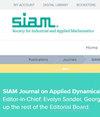Wave-Pinned Patterns for Cell Polarity—A Catastrophe Theory Explanation
IF 1.8
4区 数学
Q2 MATHEMATICS, APPLIED
引用次数: 0
Abstract
SIAM Journal on Applied Dynamical Systems, Volume 23, Issue 1, Page 721-747, March 2024.Abstract.A class of four-component reaction-diffusion systems are studied in one spatial dimension, with one of four specific reaction kinetics. Models of this type seek to capture the interaction between active and inactive forms of two G-proteins, known as ROPs in plants, thought to underly cellular polarity formation. The systems conserve total concentration of each ROP, which enables reduction to simple canonical forms when one seeks conditions for homogeneous equilibria or heteroclinic connections between them. Transitions between different multiplicities of such states are classified using a novel application of catastrophe theory. For the time-dependent problem, the heteroclinic connections represent so-called wave-pinned states that separate regions of the domain with different ROP concentrations. It is shown numerically how the form of wave-pinning reached can be predicted as a function of the domain size and initial total ROP concentrations. This leads to state diagrams of different polarity forms as a function of total concentrations and system parameters.
细胞极性的波钉模式--灾难理论的解释
SIAM 应用动力系统期刊》,第 23 卷第 1 期,第 721-747 页,2024 年 3 月。 摘要:本文在一个空间维度上研究了一类具有四种特定反应动力学之一的四成分反应扩散系统。这类模型试图捕捉两种 G 蛋白(在植物中称为 ROPs)的活性和非活性形式之间的相互作用,这两种 G 蛋白被认为是细胞极性形成的基础。这些系统保留了每种 ROP 的总浓度,因此当我们寻求它们之间的同质平衡或异质连接条件时,可以将其还原为简单的典型形式。利用灾难理论的新颖应用,可以对这些状态的不同倍数之间的转变进行分类。对于随时间变化的问题,异链连接代表了所谓的波钉状态,它将具有不同 ROP 浓度的域区域分隔开来。数值结果表明,所达到的波钉住状态的形式可作为畴尺寸和初始 ROP 总浓度的函数进行预测。这就得出了不同极性形式的状态图,它是总浓度和系统参数的函数。
本文章由计算机程序翻译,如有差异,请以英文原文为准。
求助全文
约1分钟内获得全文
求助全文
来源期刊

SIAM Journal on Applied Dynamical Systems
物理-物理:数学物理
CiteScore
3.60
自引率
4.80%
发文量
74
审稿时长
6 months
期刊介绍:
SIAM Journal on Applied Dynamical Systems (SIADS) publishes research articles on the mathematical analysis and modeling of dynamical systems and its application to the physical, engineering, life, and social sciences. SIADS is published in electronic format only.
 求助内容:
求助内容: 应助结果提醒方式:
应助结果提醒方式:


